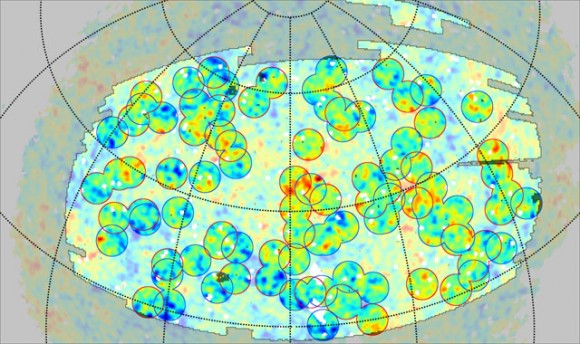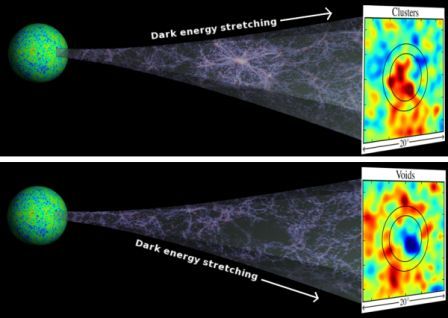[/caption]
A team of astronomers has found what they say is the clearest detection to date of dark energy in the universe. Scientists at the University of Hawaii compared an existing database of galaxies with a map of the cosmic microwave background radiation (CMB), and were able to detect dark energy’s effect on vast cosmic structures such as superclusters of galaxies, where there is a high concentration of galaxies, and supervoids, areas in space with a small number of galaxies. “We were able to image dark energy in action, as it stretches huge supervoids and superclusters of galaxies,†said Dr. István Szapudi said, from U of Hawaii’s Institute for Astronomy.
The discovery in 1998 that the universe was actually speeding up in its expansion was a surprise to astronomers. Dark energy refers to the fact that something must fill the vast reaches of mostly empty space in the Universe in order to be able to make space accelerate in its expansion. Dark energy works against the tendency of gravity to pull galaxies together and so causes the universe’s expansion to speed up.But the nature of dark energy and why it exists is one of the biggest puzzles of modern science.
The team from the University of Hawaii made the discovery by measuring the subtle imprints that superclusters and supervoids leave in microwaves that pass through them. Superclusters and supervoids are the largest structures in the universe.
“When a microwave enters a supercluster, it gains some gravitational energy, and therefore vibrates slightly faster,†explained Szapudi. “Later, as it leaves the supercluster, it should lose exactly the same amount of energy. But if dark energy causes the universe to stretch out at a faster rate, the supercluster flattens out in the half-billion years it takes the microwave to cross it. Thus, the wave gets to keep some of the energy it gained as it entered the supercluster.â€
“Dark energy sort of gives microwaves a memory of where they’ve been recently,†postdoctoral scientist Mark Neyrinck said.

When the team compared galaxies against the CMB, they found that the microwaves were a bit stronger if they had passed through a supercluster, and a bit weaker if they had passed through a supervoid.
“With this method, for the first time we can actually see what supervoids and superclusters do to microwaves passing through them,†said graduate student Benjamin Granett.
The signal is difficult to detect, since ripples in the primordial CMB are larger than the imprints of individual superclusters and supervoids. To extract a signal, the team averaged together patches of the CMB map around the 50 largest supervoids and the 50 largest superclusters that they detected in extremely bright galaxies drawn from the Sloan Digital Sky Survey, a project that mapped the distribution of galaxies over a quarter of the sky.
The astronomers say there is only a one in 200,000 chance that the evidence they detected would occur by chance.
Original News Source: U of Hawaii press release


What if it were the stretching of spacetime and the effect that has on light and not acceleration of expansion that caused the observations.
If it’s peer-reviewed work, you can be sure it’s been taken into consideration.
These guys are not dummies. They don’t miss the obvious.
Scientist are being bitten back by not understanding or missing a fundamental concept. Dark matter is playing the equivalent role of the luminiferous aether in the late 19th century science.
Dark matter hypothesis=non sense
I think a lot of people need to take a step back from this so-called “dark energy” and “dark matter” stuff and try to learn more about what we still don’t know about gravity. And undiscovered source(s) of it.
One more thing – Perhaps the “acceleration†isn’t due to repulsion, but to attraction. Perhaps we (everything we are aware of) are in a freefall towards something we have yet to discover. Gravity would most certainly come into play if that is the case.
I know it’s trendy these days to compare DM/DE to the luminiferous aether hypothesis (as it is with most ideas in cosmology that people happen to take exception to), but let’s not get ahead of ourselves.
It may indeed be the case, but it may not be – we will see. At the moment the DM/DE hypotheses are working well for us – if we don’t first characterise the attributes of the universe through research such as this and then push these theories to their logical conclusions to see where they stand and if they fail, we will never make any progress.
And for anybody to claim with certainty that DM or DE either does or does not exist, that it either is or is not an illusion born out of our measly knowledge of the universe and the laws that govern it is either guessing (=not science), letting their preconceived notions about what the universe should be like interfere with their intellectual skepticism (=not science), or are in line for a Nobel Prize and fame and glory.
And at this early stage of the debate, I’d be willing to bet nobody is in for the Nobel just yet.
Astrofiend –
Yep. I agree with you there.. Nothing wrong with having a good idea and running with it until it is proven or proven wrong. I’m still impatiently waiting for LHC data on other topics.
As the years have gone by it seems that some of us has dropped the word “theory” or “hypotheses” when referring to DM/DE. That is my concern. This article, for example, doesn’t use either of those words a single time. It is just assumed, I suppose… Yep, you are right.. No Nobels yet, or more importantly, my concurrence. :-).. Let us get some proof first.
Dark energy is the biggest filler to cover our lack of knowledge on gravity. We need some out of box thinking to answer some of these questions. How about gravity’s dual nature? i.e. to say over a great distance, gravity changes its behavior and become strong repulsive force causing the observed acceleration.
If the effect of gravity decreases with the passage of Cosmic time, then the same effect would be observed.
This increased effect of gravity would be produced by the increased density of clusters in the past.
For example, if the Earth were denser and smaller in the past, an object falling from space would gain more kenetic energy than the object would gain once the Earth expanded. (This is not an “expanding earth” model, it is an illustrative example to convay the concept).
i’m naturally skeptical of and dislike dark matter theory but this is some of the most interesting evidence for it i have yet seen.
one poster above postulated that we may all be accelerating towards an unknown destination. that sparks the imagination.
oops… dark ENERGY; not matter. *slaps wrist*
Once again you’ve claim to have “detected strong evidence” for something. You haven’t “found” dark energy, only something that seems to fit your view of how you view something. Oh God, how I miss the idiotic articles from Fraser Cain!